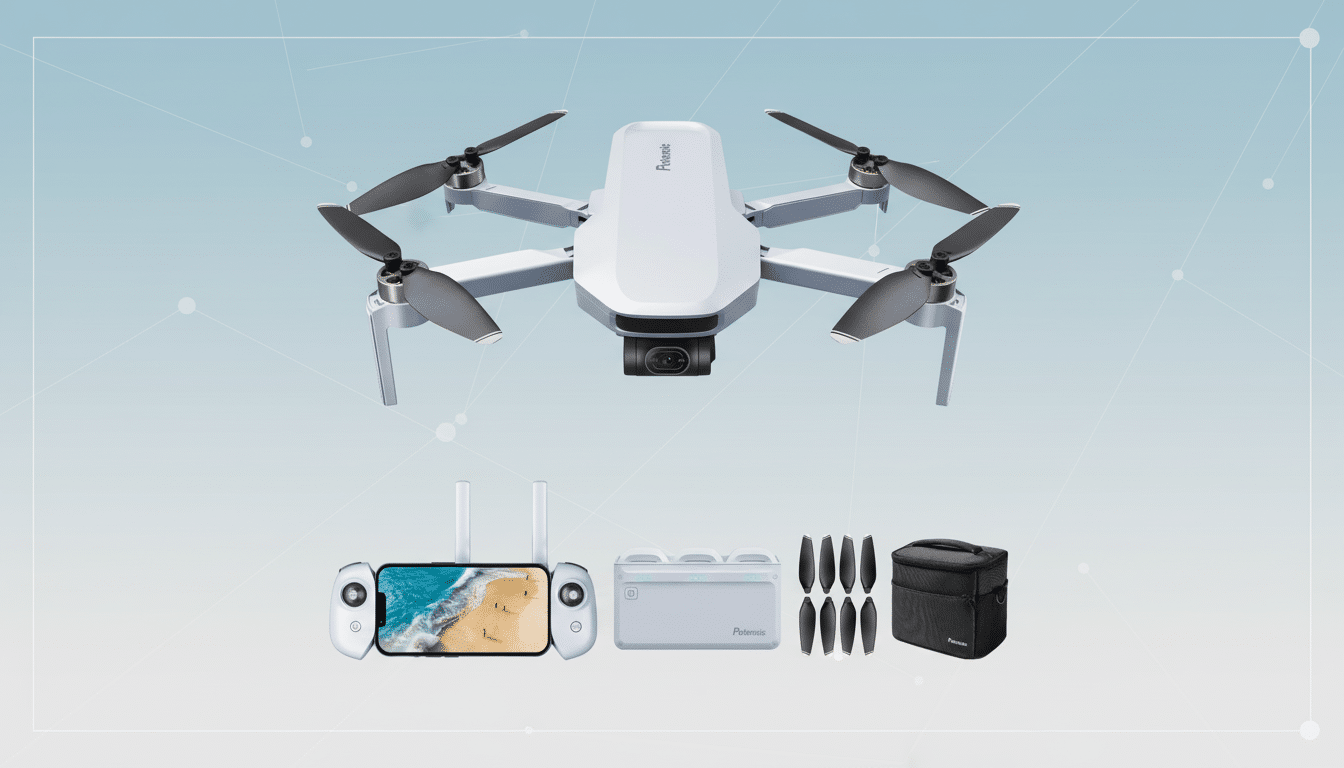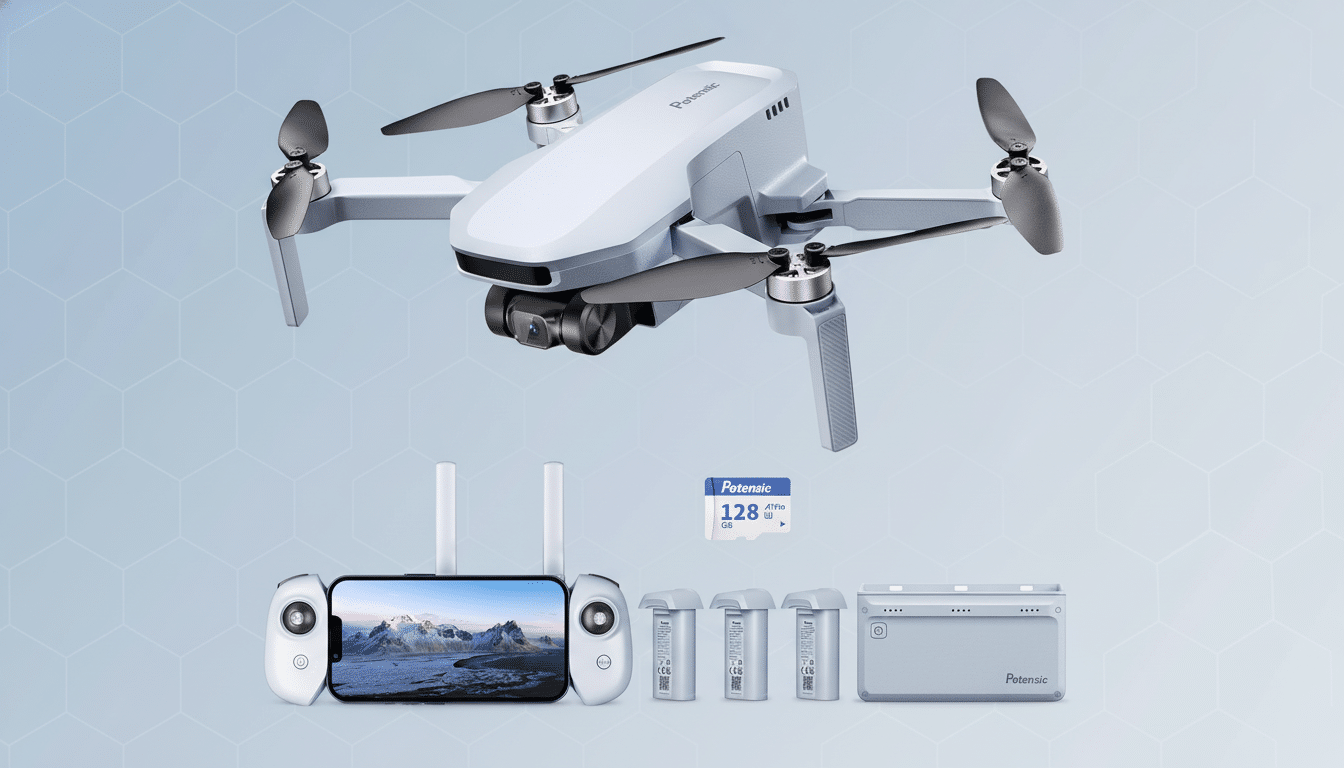Now $299 at Amazon
The Potensic Atom Fly More Combo is currently on sale for $299.99 at Amazon, and it’s a great price for a 4K camera drone that weighs just over a half-pound and comes with three batteries, a 3-axis gimbal, and a charging hub.
- What makes this sub-250g drone unique for beginners
- What’s included in the Potensic Atom Fly More bundle
- Camera modes and flight features explained simply
- How it compares on value against rival drone bundles
- Regulatory and market context for sub-250g drones
- The $299.99 deal bottom line and who should buy it

For shoppers eyeing an easy-to-use, travel-sized quadcopter with stabilized video—and a combined advertised 96 minutes of flight time in total—this deal puts the Atom on the map.
What makes this sub-250g drone unique for beginners
At less than 249 grams, the Atom is a go-to for new and leisure pilots. The Federal Aviation Administration says recreational fliers don’t need to register drones under 250 grams, which helps smooth out the decision-making for first-time buyers. That “ultralight” class also matters if you’re a traveler: You can throw this into a daypack and not feel like you have brought along an additional camera body.
It includes a 4K camera featuring a Sony CMOS sensor on a 3-axis mechanical gimbal; the Potensic Atom is an affordable drone that can produce good results in breezy conditions.
The company rates wind resistance at strength 5—about 19 to 24 mph on the Beaufort scale—so it can hold position, and keep its visual field steady, better than the toy-only drones that increasingly flood the entry-level market.
What’s included in the Potensic Atom Fly More bundle
The Fly More Combo comes with the following:
- Three intelligent batteries
- Parallel charging hub
- Remote controller
- Spare propellers
- Carry case
According to Potensic’s documentation, total airtime is about 96 minutes over the three packs—and that generally equates to somewhere between 25–30 minutes of flight time per battery, depending on wind, ascent rates, and how much full throttle you use.
The charging hub is a convenient bonus.
It charges all three simultaneously, eliminating the replace-the-packs-one-at-a-time hassle, and fully tops them off in about 80 minutes—meaning it’s easy to juice back up for another go at lunch or between locations. That convenience isn’t guaranteed in this price range.

Camera modes and flight features explained simply
Creative presets such as automated QuickShots, plus responsive visual subject tracking, make capturing the impossible shots look easy for anyone. It’s something that’s typical on higher-end rigs but is increasingly essential when you’re budgeting at the point of entry because it crams complex moves into one button press. For creators who post short-form video, this can translate into repeatable, cinematic moves without the need to hire a pilot.
It’s worth a mention of what you don’t get: sensors to avoid obstacles. The Atom uses GPS stabilization and the pilot’s line of sight, so you’re wise to fly in areas without too many obstacles. A lot of drones in this under-$300 range skip obstacle sensing to save on weight and cash, and the Atom is no exception. It also has precision landing and return-to-home functions for a safety backstop, but situational awareness is still key.
How it compares on value against rival drone bundles
For under $300, a 3-axis gimbal drone that shoots 4K video and comes with three batteries is a rare, aggressive move. Similar bundles from top brands can easily surpass $450–$600 after adding extra batteries and a charging hub. Other budget models in the same price range either scrimp on stabilization or arrive with only one battery, meaning that sensible flight time would be limited to a single brief outing.
The Atom’s pitch is pretty plain: keep the stabilized camera, keep solid endurance, trade away some premium extras like fully omnidirectional sensing. For beginners learning the sticks, hobbyists looking for a dependable traveling companion, or creators who want to step up to stabilized 4K without breaking the bank, that trade-off can make sense.
Regulatory and market context for sub-250g drones
The sub-250g category contains a regulatory buffer—and was pushed by price rather than just that. The FAA’s recreational rules exclude these ultralight drones from registration, and sub-250g models operated recreationally are not required to broadcast Remote ID signals. If you’re planning to employ any drone for commercial work, Part 107 is still in place and operators should consult FAA guidance before taking off.
Industry watchers have also observed continued scrutiny of some foreign-made drones in the United States, with policymakers debating future restrictions. That uncertainty has spurred some buyers to consider alternatives. Brand loyalty will sway differently, but the Atom’s current price tag makes it one of the few non-flagship options that won’t lead to a cold shower when thinking about where its low end stands.
The $299.99 deal bottom line and who should buy it
At $299.99, the Potensic Atom Fly More Combo offers what most beginners really want: long session time with support for three batteries, gimbal-stabilized 4K video, a small airframe under the FAA’s registration threshold, and a charger that keeps everything topped up.
And if you’re a videomaker who needs obstacle avoidance or pro-grade codecs, you’ll be shopping elsewhere upmarket. But if you just need aerial shots—and to figure out whether it’s something you really want to sink that much into—this is a bloody great deal for as long as it lasts.

